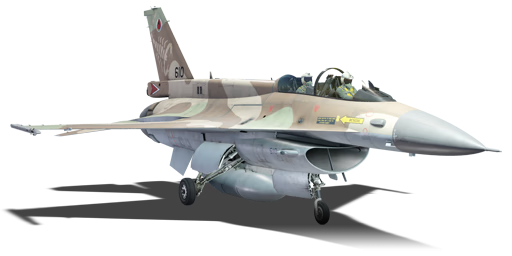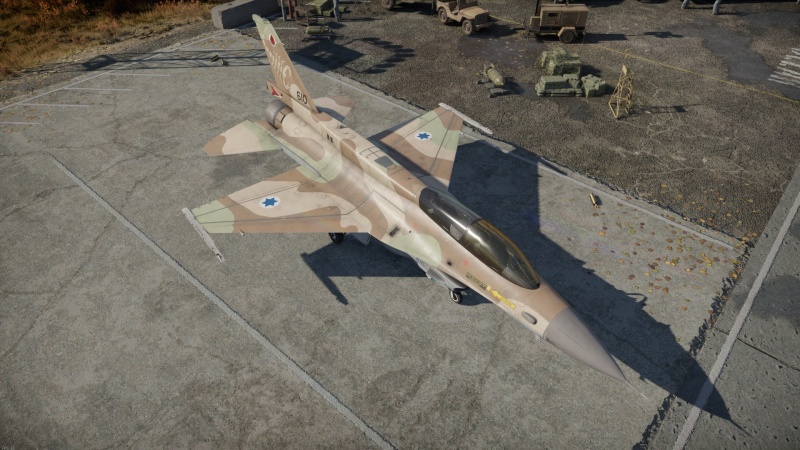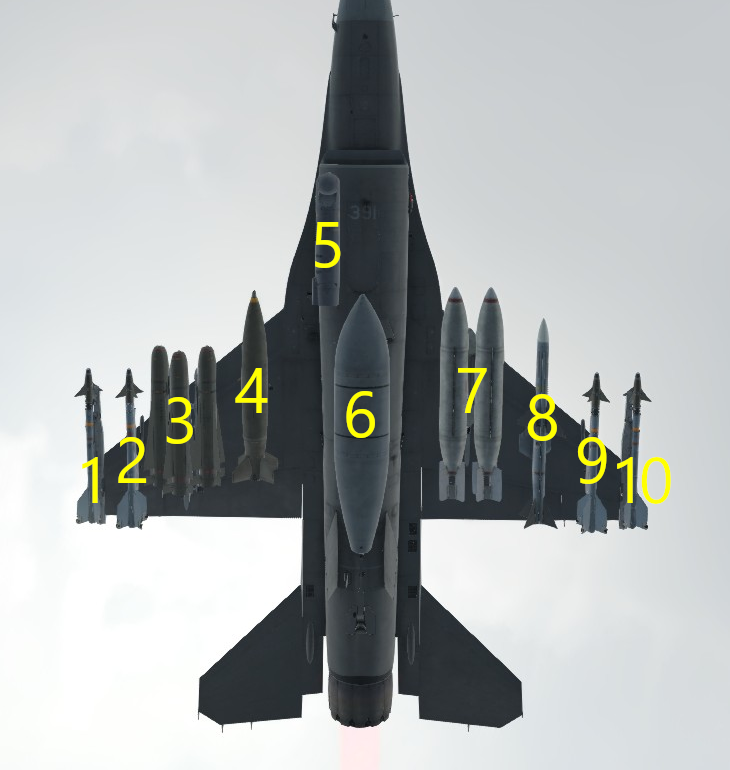F-16D Barak II
Contents
Description
During the late 1970s, Israel was designing a new jet fighter with ideas borrowed from previous aircraft they utilized. It ultimately culminated in the IAI Lavi, a fierce competitor to the F-16 Fighting Falcon in the export market. Unfortunately for Israel, the project increased in cost and was canceled for budgetary reasons. The US also had a part in the demise of the Lavi as they viewed the Lavi as a threat to the F-16’s export capability. As compensation, the US sent 24 F-16Ds and around 50 F-16Cs in 1987. A year later, under the Peace Marble III program, Israel ordered 30 F-16Cs and 30 F-16Ds. The F-16Ds received extensive modifications like refinished Multi-Function Displays and Heads-Up Displays.
Introduced in Update "Sons of Attila", the F-16D Block 40 Barak II is one of the most advanced F-16s in-game. For ground striking it can utilize the LANTIRN pod, making it an effective all-weather platform. It also has a variety of bombs to use including dumb bombs and smart bombs like the GBU-16. For air combat, the Barak II also has a variety of ordnance to use. The Barak II has access to the AIM-9M Sidewinder, an extremely capable infrared missile that boasts a unique IRCCM system and a smokeless motor. It can also carry AIM-7M Sparrows for long-range engagements. The F-16D Block 40 Barak II is a very versatile aircraft for both ground striking and air combat.
General info
Flight performance
The General Electric engine provides a very good TWR, and the Barak II is able to accelerate quite fast. The turning rate is good, but the airframe performance is inferior to the F-16A airframes since the Barak II has an increased weight. Additionally, carrying an air-to-ground payload will severely impact your flight performance. The turning rate is sufficient for most encounters.
| Characteristics | Max speed (km/h at _,___ m) |
Max altitude (metres) |
Turn time (seconds) |
Rate of climb (metres/second) |
Take-off run (metres) | |||
|---|---|---|---|---|---|---|---|---|
| AB | RB | AB | RB | AB | RB | |||
| Stock | ___ | ___ | 15240 | __._ | __._ | __._ | __._ | ___ |
| Upgraded | ___ | ___ | __._ | __._ | __._ | __._ | ||
Details
| Features | |||||
|---|---|---|---|---|---|
| Combat flaps | Take-off flaps | Landing flaps | Air brakes | Arrestor gear | Drogue chute |
| X | ✓ | ✓ | ✓ | ✓ | X |
| Limits | ||||||
|---|---|---|---|---|---|---|
| Wings (km/h) | Gear (km/h) | Flaps (km/h) | Max Static G | |||
| Combat | Take-off | Landing | + | - | ||
| 1,555 | 482 | - | 470 | 463 | ~__ | ~__ |
| Optimal velocities (km/h) | |||
|---|---|---|---|
| Ailerons | Rudder | Elevators | Radiator |
| < ___ | < ___ | < ___ | - |
Engine performance
| Engine | Aircraft mass | ||||||
|---|---|---|---|---|---|---|---|
| Engine name | Number | Basic mass | Wing loading (full fuel) | ||||
| General Electric F110-GE-100 | 1 | 9,228 kg | 447 kg/m2 | ||||
| Engine characteristics | Mass with fuel (no weapons load) | Max Gross Weight | |||||
| Weight (each) | Type | 13m fuel | 20m fuel | 30m fuel | 44m fuel | ||
| 1,778 kg | Afterburning low-bypass turbofan | 10,202 kg | 10,695 kg | 11,428 kg | 12,475 kg | 17,903 kg | |
| Maximum engine thrust @ 0 m (RB/SB) | Thrust to weight ratio @ 0 m (WEP) | ||||||
| Condition | 100% | WEP | 13m fuel | 20m fuel | 30m fuel | 44m fuel | MGW |
| Stationary | 6,646 kgf | 10,966 kgf | 1.07 | 1.03 | 0.96 | 0.88 | 0.61 |
| Optimal | 6,914 kgf (1,200 - 1,400 km/h) |
14,603 kgf (1,200 km/h) |
1.43 | 1.37 | 1.28 | 1.17 | 0.82 |
Survivability and armour
Similar to other top-tier aircraft, the Barak II doesn't have any significant armor. The airframe can take some hits from 20mm/30mm, but a good burst will easily rip control surfaces apart, destroy the engine, and knock out pilots. A direct hit from any missile will most likely destroy the plane entirely.
Modifications and economy
Armaments
| Ballistic Computer | ||||
|---|---|---|---|---|
| CCIP (Guns) | CCIP (Rockets) | CCIP (Bombs) | CCRP (Bombs) | Lead indicator |
| |
|
|
|
|
Offensive armament
The F-16D Barak II is armed with:
- 1 x 20 mm M61A1 cannon, wing root-mounted (512 rpg)
- 200 x countermeasures
The 20mm Vulcan is an excellent weapon for air-to-air combat as it has favorable projectile velocity and is very easy to aim. However, the gun has a short spool up time so players must take this into account when preparing for a short burst. Plenty of countermeasures allow for longer time in battle and players also can be less concerned about running out of flares/chaff.
Suspended armament
The F-16D Barak II can be outfitted with the following ordnance:
| 1 | 2 | 3 | 4 | 5 | 6 | 7 | 8 | 9 | 10 | ||
|---|---|---|---|---|---|---|---|---|---|---|---|
| 500 lb LDGP Mk 82 bombs | 4 | 4 | 4 | 4 | |||||||
| 500 lb Mk 82 Snakeye bombs | 4 | 4 | 4 | 4 | |||||||
| 750 lb M117 cone 45 bombs | 1, 2 | 1, 2 | 1, 2 | 1, 2 | |||||||
| 1,000 lb LDGP Mk 83 bombs | 1, 2 | 1, 2 | 1, 2 | 1, 2 | |||||||
| 2,000 lb LDGP Mk 84 bombs | 1 | 1 | 1 | 1 | |||||||
| 277 kg GBU-12 Paveway II bombs | 2* | 2* | 2* | 2* | |||||||
| 1,092 lb GBU-16 Paveway II bombs | 1* | 1* | 1* | 1* | |||||||
| 957 kg GBU-10 Paveway II bombs | 1* | 1* | 1* | 1* | |||||||
| GBU-15(V)2/B bombs | 1 | 1 | |||||||||
| AIM-7M Sparrow missiles | 1 | 1 | |||||||||
| AIM-9L Sidewinder missiles | 1 | 1 | 1 | 1 | 1 | 1 | |||||
| AIM-9M Sidewinder missiles | 1 | 1 | 1 | 1 | 1 | 1 | |||||
| AIM-9P Sidewinder missiles | 1 | 1 | 1 | 1 | 1 | 1 | |||||
| LITENING II targeting pod | 1* | ||||||||||
| 300 gal drop tanks | 1 | ||||||||||
| Maximum permissible weight imbalance: 2,000 kg | |||||||||||
| * LITENING II pod must be equipped when carrying Paveway guided bombs | |||||||||||
| Default weapon presets | |
|---|---|
| |
Usage in battles
The Barak II provides a good platform for either committing to attacking other planes, destroying ground targets in GRB with the diverse payload options, or a mixture of both. A large amount of flares/chaff helps prolong the time the Barak II can spend in battle. Players must however keep in mind that the engine burns fuel very quickly when left on afterburner.
Like all other top-tier jets, maintaining situational awareness and knowing when to engage/disengage enemies is critical to survival. Especially in GRB, keep an eye out for enemy SPAA and be ready to take evasive maneuvers when your RWR is pinged or if you spot a missile.
When bringing the Barak II to GRB, the player can choose to either use conventional bombs or the "smart" GBU guided bombs. The four 2000lbs are very useful for taking out enemy tanks quickly when rushing, but the player again must be beware of ground SPAA and anti-air fire since the Barak II lacks armor. After bombs are expended, players can use their anti-air missiles against enemy planes if they choose to do so.
In ARB, the Barak II is best suited to plane-to-plane combat as it will benefit the team the most, and the Barak II's flight performance is significantly reduced when carrying bombs of any kind. It is better to not commit to close-range fights as you can easily be killed by other enemies while you are focused on eliminating someone, however the 20mm Vulcan makes downing planes quite easy if you need it. Make sure to utilize your AIM-9Ms as they are very effective at taking out enemy planes.
Pros and cons
Pros:
- Access to the deadly AIM-9M missiles
- Excellent loadout variety for ground attack and Air to Air combat
- Good flight performance and maneuverability in most situations
- Large number of countermeasures for prolonged combat, allows for some leniency in countermeasure use
- Engines provide very good TWR (thrust to weight ratio)
Cons:
- Inferior flight performance to the normal F-16A airframe due to additional weight
- Carrying bombs or external ground-strike payload negatively impacts flight performance
- Engine consumes fuel very quickly when on WEP/afterburner
- No armor of any kind, extremely vulnerable to ground and air munitions of any kind
- Large engine gives off a significant heat signature for IR missiles, even when afterburner is off
- Tier III and Tier IV modifications take some time to research for non-premium players
History
In the late 1970s, Israel began its ambitious project to produce its first locally-manufactured jet fighter, meant to replace the aging IAI Kfir. Learning from their previous work on the Mirage and Kfir programs, and borrowing ideas from America's then-new F-16A fighter jet (which had entered IAF service in 1980 as the "Netz"), Israeli aeronautic engineers were able to develop a highly-manoeuvrable, delta-wing, single-seat fighter of their own - the IAI Lavi.
After nearly a decade of development the Lavi's first prototype was flown in 1986, and reportedly proved extremely capable. The United States, which had up to that point supported and partially funded the Lavi project, was dismayed to learn that the new aircraft might be good enough to provide a much cheaper competitor for the F-16 on the export market. The Reagan administration soon began pressuring the Israeli government to cancel the project. Though Israel's defense minister Moshe Arens was strongly behind the Lavi, the project's ever-increasing pricetag made it easy for the rest of the Israeli government to agree to US demands. The Lavi project was finally canceled in late 1987.
As compensation for torpedoing Israel's fighter manufacture ambitions, the United States agreed to sell Israel additional F-16Cs and Ds. A significant number of them, all from the Block 30 model, had already been sold to Israel by that point, entering IAF service under the codename "Barak" (Lightning) in late 1987. In 1988, the US and Israel signed that new "compensation" deal - named "Peace Marble III" - delivering a total of 60 F-16s, all from Block 40, between 1991 and 1993. Half were F-16Cs and half were F-16Ds (single-seat and double-seat, respectively). In the IAF, these new Block 40 aircraft were named "Barak II" (Lightning II), correspondingly amending the name of the older Block 30 aircraft to "Barak I" (note: the IAF does not keep separate names for single- and double-seat variants of the F-16).
The F-16C/D has several advantages over the F-16A/B, but the most important is the ability to mount a LANTIRN pod, turning the plane into an all-weather operator. As Israeli engineers had done with all other combat planes purchased for the IAF in the last 50 years, they also updated most of the avionics and introduced many locally-manufactured, cutting-edge improvements. This included completely redone Multi-Function Displays (MFDs) and in-helmet Heads-Up Display (HUD), among multiple other additions like the newest locally-manufactured IR missile the Python-4 and later the Active-Radar-Homing Rafael Derby Missile.
Barak II aircraft have taken part in almost every Israeli military campaign since their introduction, including the Second Lebanon War of 2006. Nevertheless, the changing needs of the Israeli Air Force have created a demand for a more dedicated fighter in the long-distance and precision-strike roles, resulting in the birth of the F-16I "Sufa". This heavily-modified F-16D Block 52 has since completely replaced the Barak in those roles, leaving it only with mid-altitude interception duties, which it still performs to this day. However, with the F-35 "Adir" now increasingly filling that role, there are ever-growing calls within the Israeli military community to finally retire the Barak II.
Media
Excellent additions to the article would be video guides, screenshots from the game, and photos.
See also
F-16 and its variants: F-16 (Family) - War Thunder Wiki
Israeli Aviation tech tree: Israel aircraft - War Thunder Wiki
External links
| General Dynamics Corporation | |
|---|---|
| Jet Fighters | F-16A · F-16A ADF · F-16C |
| Strike Aircraft | F-111A · F-111F |
| Export | ▄F-16A ADF · ▄F-16A · ▄F-16AM · ␗F-16A MLU · F-16AJ · Netz · F-16D Barak II · F-16C Barak II |
| F-111C | |
| See also | SABCA |
| Israel jet aircraft | |
|---|---|
| Kfir Canard · Kfir C.2 · Kfir C.7 · Nesher | |
| Britain | |
| Meteor | Meteor NF.13 · Meteor F.8 |
| France | |
| Vautour | Vautour IIA · Vautour IIN |
| Super Mystere | Sambad · Sa'ar |
| Mirage III | Shahak |
| Other | M.D.450B Ouragan · Mystere IVA |
| USA | |
| F-84 | F-84F |
| A-4 | A-4H · A-4E Early (M) · A-4E · Ayit |
| F-4 | Kurnass · Kurnass 2000 |
| F-15 | Baz · Baz Meshupar · F-15I Ra’am |
| F-16 | Netz · F-16C Barak II · F-16D Barak II |






